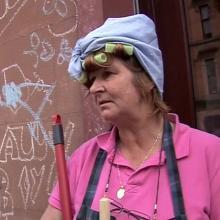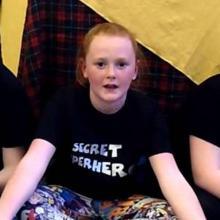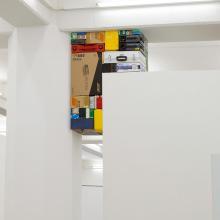Tayside Healthcare Arts Trust (THAT) believes in the power of the arts to enhance quality of life, to promote inclusion, to empower and to improve well being. THAT was established in 2002 to meet the demand for an agency to develop Arts in Health opportunities across Tayside and it now employs professional artists to deliver partnership programmes in both inpatient and community settings.
Funding
THAT is an independent charity partly funded by NHS Tayside with specific projects also funded by Creative Scotland and others.
Who runs it?
Project design and evaluation is managed by THAT staff. The participatory arts sessions are run by professional freelance artists, as well as volunteer artists. Participants in the groups are actively involved in discussions about what sorts of activities are provided.
Who are the key partners?
THAT has considerable experience of working with a wide range of partners. They have delivered projects in partnership with NHS Tayside, voluntary agencies such as Chest Heart & Stroke Scotland, Parkinson’s Society, Alzheimer Scotland, Speakeasy and Multiple Sclerosis Society, as well as cultural partners; Dundee Contemporary Arts, University of Dundee and Horsecross Arts.
How do people hear about it?
THAT targets particular groups it thinks might be interested in activities and uses the relationships it has with NHS Tayside and voluntary organisations to recruit participants. Health professionals and community nurses will often refer individuals and self-referrals are also accepted.
Which art forms do you use?
Originally a visual arts agency, THAT now delivers projects using virtually every art form (creative writing, music, dance and performance). The interests and abilities of the people who are in the group, but also by the funding streams that are available for the work and the skills and availability of the artists determine a large part of deciding which art form to use.
What are the outcomes?
It is recognised that a lot of people do not explore their creative potential, often because they have been told from a young age that they can’t draw or can’t sing, which makes them believe the arts is not for them. However, THAT advocates that with the right sort of support, people can reveal huge amounts of artistic potential and can have enormous fun exploring it.
THAT feels that the strength of its work is that it engages participants in positive activity with the support and guidance of professional artists (visual, musical, performance, written) that allows them to experience the immersion and exhilaration that can be achieved through the arts. This, in turn, produces very important discrete benefits that have influence far beyond the realms of the programme workshop. Improved confidence and self belief can, in turn, lead to greater social engagement which reduces loneliness and anxiety (potentially reducing doctors visits and medication requirements).
However, it is important to recognise that engagement in the arts is also really good fun! It allows people to have a good time when, because of their health, they find it very difficult to access opportunities. THAT have found that the psychosocial benefits of involvement in the arts include:
- enhanced quality of life
- increased self esteem and confidence
- positive social engagement with others
- increased access to the arts
- opportunity to explore creativity
- improved wellbeing
The Art as Creative Engagement for Stroke (ACES) study, a current CSO funded research study involving THAT, provides evidence for use of participatory arts in inpatient settings for those who have suffered a stroke. It is exploring participants outcomes such as increased confidence and self esteem, the positive reframing of self-identity, being more culturally and socially engaged and the fun and pleasure for those involved.
It is also instructive for care staff who see the creative ability of individuals, which changes their perceptions of them. Through the creative process, staff pick up information on a person’s history and life experiences, which stops them being viewed solely in terms of their condition, but as individuals. The results of the ACES Study will be published in 2015
How is quality measured?
As well as being actively engaged in the design of programming and content, artists employed by THAT are involved in reflective reporting about their role in leading programmes. Learning is to a degree an iterative process through accumulative experience but also through the consistent engagement with THAT as the project lead and the various partners and participants.
What are the challenges?
There is a real danger that falling funding support to voluntary and third sector organisations and increasing emphasis on achieving sustainability may mean that Scotland (and Britain) will not advance this work as urgently as it should.
Social care staff often don’t feel that they have the skills and experience to sustain the arts in the working day. Staff can also be dismissive unless they have been exposed to the process. Exposure is required at ground level and there needs to be buy-in to, and recognition of, its value at management level.
How do you evaluate?
THAT has developed their own evaluation procedure in conjunction with participants and programming partners. As well as collecting anecdotal evidence and questionnaire responses from participants, review and evaluation is worked into each programme and by consistently using the same methodology, THAT is also able to present information on a cumulative annual basis.
What are the key characteristics of effective practice?
- Broad skill base - it is important to recruit a variety of artists with different skills and experiences. This ensures a wide pool of people from which to devise programmes to suit participant needs.
- The equal importance of process and product is fundamental to the success of a programme. While the sessions need to be structured to ensure that people can engage, relax and develop appropriately, the creative output or product is a tangible outcome that people can showcase and take pride in, and use as a way of projecting their personality beyond the confines of their condition. A lot of people understand their current position based on what it is they are no longer able to do, but the engagement in participatory arts can challenge this thinking by helping to reveal what they can do.
- Forward planning - programmes need to be well thought out and planned in order for them to be delivered effectively.
- Good communication skills and empathy - artists need to be able to listen attentively, and to demonstrate patience and understanding when working with individuals.
- Sessions should not be overly prescribed - the tone of the sessions need to be informal and inclusive. A level of flexibility is required in the event that something is not working or needs to be refined.
Recommendations
- The skills of professional participatory artists need to be recognised, respected and rewarded appropriately.
- Although important to the process it is difficult to fully co produce projects due to the nature of the funding streams available i.e. often THAT apply for funding two or three years in advance and many funding agencies seek details on the art forms and types of activities that will be delivered well in advance. Participants and local programme partners may not be able to plan that far ahead.
- The pleasure principle of involvement in the arts is its first and foremost attraction. Encouraging people to get involved on the basis of stimulation and having fun is the best way to recruit people.
- The creative skills of social care staff and the value these skills can bring to their role should be recognised.
- Building long-term relationships through providing a series of short-term programmes can result in very positive outcomes. Retaining and maintaining relationships over a number of years often results in higher levels of engagement and skills development and encourages people to continue to explore new activities.
- Greater support for research into the role of participatory arts in health will further reveal the significant potential and benefits to be secured.




